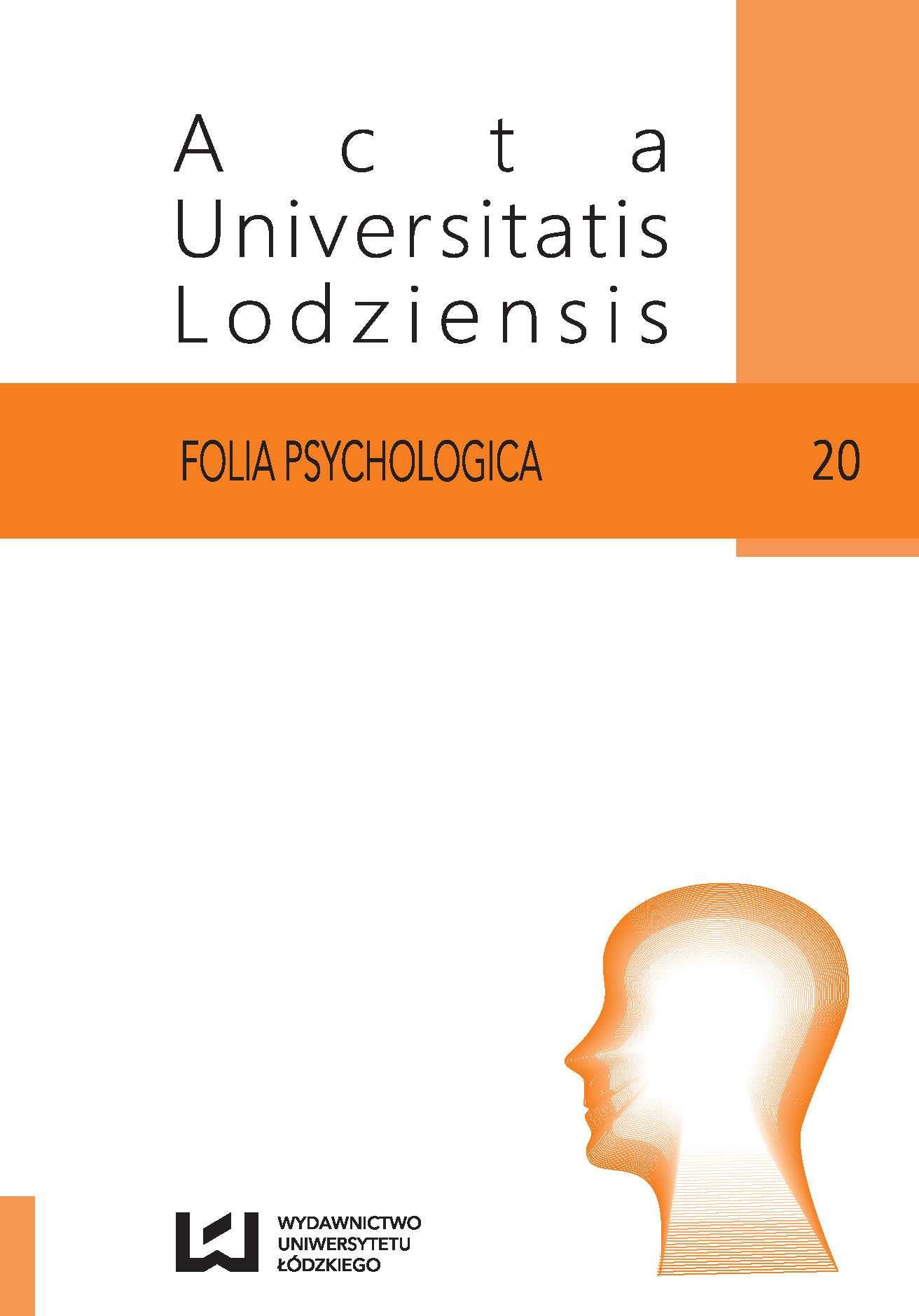The Narrative Games in Psychological Diagnosis and Therapy. Possibilities and Limitations in their Apllication
DOI:
https://doi.org/10.18778/1427-969X.20.03Keywords:
narrative games, psychological diagnosis, psychological therapyAbstract
The article concerns possible use of narrative games in psychology. Narrative games are recognized as projective games, which allow to reach some hidden needs and motives of players by means of using the game world – a set of symbols which have a personal meaning for the players. Diagnosis of the players is possible due to analyzing characteristics and behavior of the characters they create. Therapy with the use of narrative games allows to support treatment of some mental disorders (such as phobia or depression), helps to develop social skills, to cope with unpleasant emotions and to create ways of thinking. Contraindications against the use of narrative games in diagnosis and therapy include psychotic and personality disorders, intellectual defi cits, and inability to separate the Self from the Self-of-Character.
References
Abyeta S., Forest J. (1991). Relationship of role-playing games to self-reported criminal behaviour. Psychological Reports, 69 (3), December, 1187–1192.
Google Scholar
Acland A. F. (2000). Doskonałe umiejętności interpersonalne: wszystko, czego potrzebujesz, aby udało ci się za pierwszym razem, tłum. M. Makowska. Poznań: Dom Wydawniczy REBIS.
Google Scholar
Ascherman L. I. (1993). The impact of unstructured games of fantasy and role playing on an inpatient unit for adolescents. International Journal of Group Psychotherapy, 43 (3), 335–344.
Google Scholar
Bartle R. (1996). Hearts, clubs, diamonds, spades: Players who suit MUDs, http://www.mud.co.uk/richard/hcds.html [dostęp: 25.01.2014].
Google Scholar
Betz U. A. K. (2011). What fantasy role-playing games can teach your children (or even you). British Journal of Educational Technology, 42 (6), E117–E121.
Google Scholar
Bélisle J.-F., Bodur H. O. (2010). Avatars as Information: Perception of Consumers Based on Their Avatars in Virtual Worlds. Psychology and Marketing, 27 (8), 741–765.
Google Scholar
Blackmon W. D. (1994). Dungeons and Dragons: The Use of a Fantasy Game in the Psychotherapeutic Treatment of a Young Adult. American Journal of Psychotherapy, 48 (4), 624–632.
Google Scholar
Carter R., Lester D. (1998). Personalities of players of Dungeons and Dragons. Psychological Reports, 82, 182.
Google Scholar
Chmielnicka-Kuter E. (2004). Gry fabularne w badaniach psychologicznych. Polskie Forum Psychologiczne, 9 (2), 124–138.
Google Scholar
Chmielnicka–Kuter E. (2005). Wyobrażone postacie i ich autorzy: analiza wzajemnych odniesień na przykładzie zjawiska gier fabularnych. Przegląd Psychologiczny, 48 (1), 53–73.
Google Scholar
Cierpiałkowska L., Czabała C. (2007). Psychoterapia indywidualna i grupowa. [W:] H. Sęk (red.), Psychologia kliniczna (t. 1, s. 269–298). Warszawa: Wydawnictwo Naukowe PWN.
Google Scholar
DeRenard L. A., Kline L. M. (1990). Alienation and the game dungeons and dragons. Psychological Reports, 66, June, 1219–1222.
Google Scholar
Emunah R. (1994). Acting for Real. Drama Therapy, Process, Technique, and Performance. New York, London: Brunner-Routledge.
Google Scholar
Goleman D. (1997). Inteligencja emocjonalna, tłum. A. Jankowski. Poznań: Wydawnictwo Media Rodzina.
Google Scholar
Hsu S. H., Kao C.-H., Wu M.-C. (2007). Factors Infl uencing Player Preferences for Heroic Roles in Role-Playing Games. Cyberpsychology and Behavior, 10 (2), 293–295.
Google Scholar
Hughes J. (1988). Therapy is Fantasy: Roleplaying, Healing and the Construction of Symbolic Order. Paper presented in Anthropology IV Honours, Medical Anthropology Seminar, Dr. Margo Lyon, Dept. of Prehistory and Anthropology, Australian National University, http://www.rpgstudies.net/hughes/therapy_is_fantasy.html [dostęp: 12.01.2015].
Google Scholar
Landy R. (2009). Role theory and role method of dramatherapy. [W:] D. R. Johnson, R. Emunah (red.), Current Approaches in Dramatherapy (s. 65–88). Springfi eld, Illinois: Charles C. Thomas Publisher.
Google Scholar
Mellibruda J. (2003). Ja – ty – my: psychologiczne możliwości ulepszania kontaktów międzyludzkich. Warszawa: Instytut Psychologii Zdrowia PTP.
Google Scholar
Paluchowski W. J., Hornowska E. (2003). Problemy teoretyczne diagnozy psychologicznej. [W:] J. Strelau. (red.), Psychologia. Podręcznik akademicki. Podstawy psychologii (t. 1, s. 509–519). Gdańsk: Gdańskie Wydawnictwo Psychologiczne.
Google Scholar
Panak P., Drzewiecka O. (2005). Gry fabularne. Mit a rzeczywistość: potencjalne wykorzystanie technik narracyjnych gier fabularnych w dydaktyce, pedagogice i terapii. „Szkoła Specjalna”, 66(1), 19–29.
Google Scholar
Prajzner K. (2009). Tekst jako świat i gra. Modele narracyjności w kulturze współczesnej. Łódź: Wydawnictwo Uniwersytetu Łódzkiego.
Google Scholar
Rein-Hagen M., Davis G., Dowd T., Stevens L., Wieck S. (2002). Wampir: Maskarada. Narracyjna Gra Grozy. Warszawa: Wydawnictwo ISA Sp. z o.o.
Google Scholar
Rembowski J. (1986). Metoda projekcyjna w psychologii dzieci i młodzieży. Warszawa: Państwowe Wydawnictwo Naukowe.
Google Scholar
Russoniello C., O’Brien K., Parks J. M. (2009). The eff ectiveness of casual video games in improving mood and decreasing stress. Journal of Cyber Therapy and Rehabilitation, 2 (1), 53–66.
Google Scholar
Simon A. (1987). Emotional Stability Pertaining to the Game of Dungeons and Dragons. Psychology in the Schools, 24, 329–332.
Google Scholar
Simon A. (1998). Emotional stability pertaining to the game Vampire: The Masquerade. Psychological Reports, 83 (2), 732–734.
Google Scholar
Stasiakiewicz M. (2003). Testy projekcyjne. [W:] J. Strelau (red.), Psychologia. Podręcznik akademicki. Podstawy psychologii (t. 1, s. 491–503). Gdańsk: Gdańskie Wydawnictwo Psychologiczne.
Google Scholar
Szeja J. Z. (2004). Gry fabularne. Nowe zjawisko kultury współczesnej. Kraków: Wydawnictwo Rabid.
Google Scholar
Szymanik A., Kostrzewski M. (2012). Gry narracyjne jako metoda i narzędzie w nauce. Forum Dydaktyczne. Przeszłość – Teraźniejszość – Przyszłość, 9–10, 166–178.
Google Scholar
Szymanik A., Mączyńska J. (2010). Wykorzystanie gry narracyjnej w diagnozie i terapii – możliwości i ograniczenia. Wystąpienie na konferencji „Homo narrator. Badanie opowieści o doświadczeniu”. Spała, 3–5 listopada 2010 r.
Google Scholar
Taylor S. E., Klein L. C., Lewis B. P., Gruenewald T. L., Gurung R. A. R., Updegraff J. A. (2000). Biobehavioral responses to stress in females: Tend-and-befriend, not fi ght-or-fl ight. Psychological Review, 107 (3), 411–429.
Google Scholar
Thayer R. E., Newman J. R., McClain T. M. (1994). Self-regulation of mood: strategies for changing a bad mood, raising energy, and reducing tension. Journal of Personality and Social Psychology, 67 (5), 910–925.
Google Scholar









